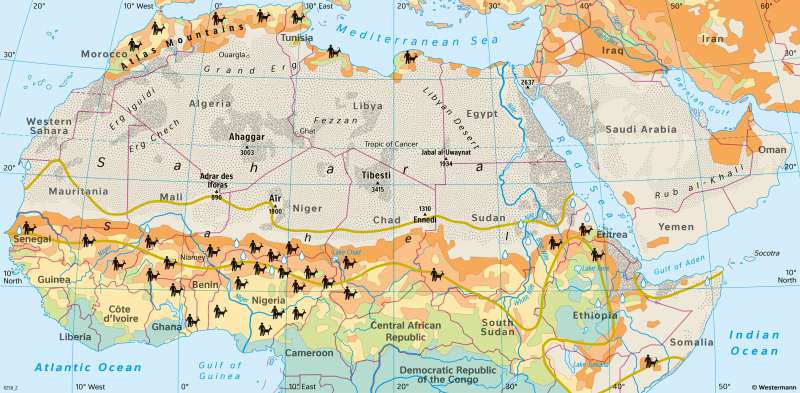Sahara and Sahel - Desert landforms
Vegetation and agriculture
978-3-14-100890-6 | Page 149 | Ill. 2

Overview
Desertification is a process of progressive degradation of the productive capacity of symbiotic nature-human systems, which are mainly characterised by a high degree of adaptation to arid and semi-arid conditions. In its final state, it leads to the emergence of "man-made deserts". The main causes of desertification are deflations of soil in areas with loose soils, soil washing and soil skeletonisation in mountainous regions, and finally soil salinisation in areas with excessive irrigation and poor drainage or with non-adapted irrigation methods.
Desertification in Northern Africa
The map shows that large parts of Africa and Western Asia are now moderately to very severely affected by desertification. On the one hand, this includes practically all desert fringe areas such as semi-deserts, steppes, and briar savannas, where the destruction of soil and flora can no longer be compensated for by natural regeneration. On the other hand, these are areas with a more favourable natural environment, such as the dry savannas of the southern Sahel, which are used more intensively by humans than the regions to the north. Such areas are now severely affected by excessive overgrazing, the expansion of arable land and deforestation. Since the chances of successfully fighting desertification in developing countries are slim to moderate at best due to the lack of capital there, many processes must be regarded as irreversible.
Desertification is a complex phenomenon, decisively caused by humans, which can be accelerated by natural influences such as rainfall variability and droughts. The vulnerability of certain soil types to the processes of deflation, fluvial erosion, soil skeletonisation, salinisation and alkalinisation can also have a reinforcing influence.
Both the resident population and outsiders can be responsible for human interventions in the nature-human system, be it political decision-makers of the government, domestic and foreign investors or, as in historical times, colonial administrations, and rulers. The permanent overexploitation of limited resources can, for example in the Sahel area, be a consequence of the interplay of population pressure, inappropriate agriculture, and lack of rainfall. Studies on desertification also show that the current land use of arid and semi-arid areas differ severely from the adjusted land use of human societies in the centuries before.
Once started, the desertification process often develops its own self-reinforcing dynamics. The initial consequences are of an ecological-physical nature and manifest themselves in various forms of soil degradation and biological degradation. This can ultimately result in a range of serious social, economic, and political consequences, from devastating famines to political unrest.
There are measures to fight desertification, but they are not always easy to implement and not effective everywhere. For example, agricultural engineering methods are used to at least contain the progressive desertification through appropriate cultivation practices. A sustainable solution to the problem would have to include incentive measures for the affected people in developing countries to earn their livelihoods outside of agriculture and, at the same time, apply such methods of cultivation that are in the greatest possible harmony with climatic, pedological and human ecological conditions. Such long-term measures would also make more economic sense than intensive farming aimed at rapid profit maximisation. It is therefore advisable to study local systems and adapt them gently to current conditions.




